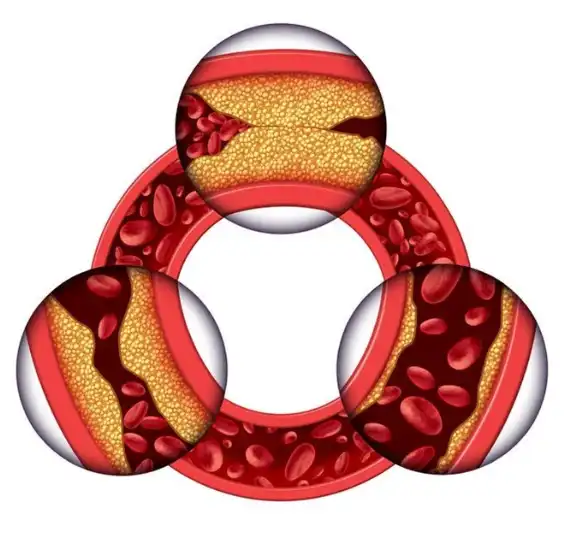As a potent weapon in the fight against excessive cholesterol levels, atorvastatin powder has given millions of people fighting this prevalent health problem reason to hope. One of the statin class of medications, atorvastatin, effectively lowers blood cholesterol levels by inhibiting an enzyme necessary for the creation of cholesterol in the liver. Thanks to its ability to reduce levels of "bad" cholesterol (LDL) while simultaneously boosting levels of "good" cholesterol (HDL), this medication has garnered a lot of interest. As atorvastatin powder works to lower cholesterol levels as well as total cholesterol, it provides a holistic solution for cardiovascular disease prevention and health management.

How does Atorvastatin powder compare to other cholesterol-lowering medications?
Efficacy in Lowering LDL Cholesterol
In terms of reducing levels of bad cholesterol (LDL), atorvastatin powder has shown to be far more effective than other statins and cholesterol-lowering drugs. Depending on the dosage, atorvastatin has the potential to lower LDL cholesterol by as much as 50%, according to studies. Patients at high risk for cardiovascular events or with very raised cholesterol levels may benefit greatly from its powerful effect. Compared to other statins like simvastatin or pravastatin, atorvastatin powder typically achieves greater reductions in LDL cholesterol at equivalent doses. Atorvastatin is often prescribed by doctors as an aggressive lipid-reducing treatment since it is more successful at lowering LDL cholesterol than non-statin drugs like ezetimibe.
Safety Profile and Side Effects
When considering the safety profile of atorvastatin powder in comparison to other cholesterol-lowering medications, it generally exhibits a favorable risk-benefit ratio. Atorvastatin, like other statins, carries the risk of myalgia and, very rarely, rhabdomyolysis, which are side effects related to the muscles. However, the incidence of these side effects is relatively low and comparable to other statins. Atorvastatin powder may have a slightly higher risk of liver enzyme elevations compared to some other statins, but this is typically mild and reversible. In contrast to some non-statin medications, such as bile acid sequestrants or niacin, atorvastatin powder is generally better tolerated and associated with fewer gastrointestinal side effects. This improved tolerability might lead to more consistent cholesterol medication over the long term and better patient adherence.
Long-term Cardiovascular Benefits
The well-established long-term cardiovascular benefits of atorvastatin powder are one of the main advantages it has over other drugs that decrease cholesterol. The effectiveness of atorvastatin in lowering cholesterol levels and reducing the risk of serious cardiovascular events, including as heart attacks and strokes, has been proven in multiple large-scale clinical trials. The ASCOT-LLA trial, for example, showed that atorvastatin reduced the risk of coronary events by 36% in patients with hypertension and other cardiovascular risk factors. Just as atorvastatin reduced the risk of initial cardiovascular events in individuals with type 2 diabetes by 37% in the CARDS study, so too did similar results. These robust clinical outcomes set atorvastatin powder apart from some other cholesterol-lowering medications that may lack such extensive long-term data on cardiovascular protection.
What is the recommended dosage for Atorvastatin powder?
Initial Dosing and Titration
The recommended dosage for atorvastatin powder typically starts at a lower dose and may be adjusted based on individual patient response and tolerability. For most patients, the initial dose is 10 mg or 20 mg once daily, taken in the evening or at bedtime. This timing is based on the fact that cholesterol synthesis in the liver is highest during nighttime hours. However, some healthcare providers may recommend morning dosing if it helps with adherence. In patients with very high LDL cholesterol levels or those at high risk for cardiovascular events, a starting dose of 40 mg may be considered. It's important to note that atorvastatin powder should be taken consistently at the same time each day to maintain stable blood levels and maximize its cholesterol-lowering effects.
Dose Adjustments Based on Response
After initiating atorvastatin powder therapy, healthcare providers typically monitor the patient's lipid profile and adjust the dosage as needed to achieve target cholesterol levels. The dose may be increased at intervals of 2 to 4 weeks if the desired LDL cholesterol reduction is not achieved. The maximum recommended dose of atorvastatin powder is 80 mg once daily, which is reserved for patients who require intensive lipid-lowering therapy. It's worth noting that the relationship between dosage and LDL cholesterol reduction is not linear; doubling the dose typically results in an additional 6-7% reduction in LDL cholesterol. Therefore, the decision to increase the dose should be balanced against the potential for increased side effects at higher doses. Regular monitoring of lipid levels and liver function tests is essential to ensure the appropriate dosage is maintained.
Special Population Considerations
When prescribing atorvastatin powder, healthcare providers must consider special populations that may require dose adjustments. For elderly patients or those with impaired renal function, a lower starting dose of 10 mg daily is often recommended, with careful titration based on response and tolerability. Patients with hepatic impairment may also require lower doses, and atorvastatin is contraindicated in those with active liver disease. In patients taking certain medications that interact with atorvastatin, such as cyclosporine, clarithromycin, or protease inhibitors, dose reductions may be necessary to minimize the risk of adverse effects. Additionally, for patients of Asian descent, who may have increased systemic exposure to atorvastatin, starting with a lower dose and careful monitoring is advised. When it comes to safely and successfully managing cholesterol levels with atorvastatin powder, these factors emphasize the significance of customized dosing regimens.
Are there any lifestyle changes that can enhance the effectiveness of Atorvastatin powder?
Dietary Modifications
While atorvastatin powder is highly effective in lowering cholesterol levels, its benefits can be significantly enhanced through dietary modifications. Adopting a heart-healthy diet low in saturated and trans fats can work synergistically with atorvastatin to further reduce LDL cholesterol levels. To optimize lipid profiles, consume more fruits, vegetables, whole grains, and lean proteins and less processed foods, red meat, and full-fat dairy. Soluble fiber, found in abundance in foods like psyllium, beans, and oats, can help lower cholesterol absorption in the intestines. According to research, atorvastatin powder has a greater impact on improving cardiovascular health and lowering LDL cholesterol levels when combined with a plant-based or Mediterranean-style diet compared to medicine alone.
Regular Physical Activity
One more important thing you can do to improve the efficacy of atorvastatin powder in controlling cholesterol levels is to start exercising regularly. In addition to aiding in weight loss and general cardiovascular health, aerobic workouts like jogging, cycling, swimming, or brisk walking can increase HDL cholesterol levels. Adults should aim for 75 minutes of strong aerobic activity each week or 150 minutes of moderate aerobic activity, according to the American Heart Association. Resistance training exercises, performed 2-3 times per week, can also be beneficial in improving lipid profiles and body composition. The combination of atorvastatin powder and consistent physical activity has been shown to yield greater improvements in cholesterol levels and cardiovascular risk factors compared to either intervention alone.
Stress Management and Sleep Optimization
Managing stress and optimizing sleep patterns are often overlooked but important lifestyle factors that can complement the cholesterol-lowering effects of atorvastatin powder. Elevated cholesterol levels and an increased risk of cardiovascular disease have been associated with chronic stress. You can lessen the detrimental effects of stress on cholesterol metabolism by using stress-reduction strategies like yoga, meditation, deep breathing, or participating in hobbies. Maintaining appropriate cholesterol levels also depends on getting enough good sleep. A higher risk of cardiovascular disease and changes in lipid metabolism have been linked to irregular sleep patterns. Aiming for 7-9 hours of sleep per night and maintaining a consistent sleep schedule can support the body's natural cholesterol regulation processes and enhance the effectiveness of atorvastatin powder in managing overall lipid profiles.
Conclusion
The cholesterol-lowering and heart-healthy effects of atorvastatin powder have been well-documented. The benefits can be amplified when you add heart-healthy eating, frequent exercise, stress management, and good sleep hygiene to your routine. While atorvastatin is generally well-tolerated, it's crucial to follow recommended dosages and consult healthcare providers for personalized treatment plans. Optimizing cholesterol management and improving overall cardiovascular health can be achieved by combining medication with beneficial lifestyle modifications.
For high-quality atorvastatin powder and other APIs, Xi'an Salis Biological Co., Ltd. is a trusted supplier. Established in 2023, our company is committed to providing premium pharmaceutical ingredients backed by rigorous quality control and innovative research. For inquiries, please contact us at lea_slsbio@163.com,WhatsApp+86 13193326505.

FAQ
Q: How long does it take for atorvastatin powder to lower cholesterol?
A: Generally, you may see a significant reduction in cholesterol levels within 2-4 weeks of starting atorvastatin, with maximum effects typically observed within 4-6 weeks.
Q: Can atorvastatin powder be taken with other medications?
A: While atorvastatin can be taken with many medications, it's important to inform your healthcare provider about all drugs you're taking, as some may interact with atorvastatin.
Q: Are there any foods to avoid while taking atorvastatin powder?
A: Grapefruit and grapefruit juice should be avoided or limited, as they can increase the concentration of atorvastatin in your blood, potentially leading to side effects.
Q: Can lifestyle changes replace the need for atorvastatin powder?
A: For some individuals with mildly elevated cholesterol, lifestyle changes alone may be sufficient. However, many people require medication in addition to lifestyle modifications for optimal cholesterol management.
Q: Is it safe to drink alcohol while taking atorvastatin powder?
A: Moderate alcohol consumption is generally considered safe, but excessive drinking can increase the risk of liver problems when taking atorvastatin.
References
1. Naci, H., Brugts, J. J., & Ades, T. (2013). Comparative tolerability and harms of individual statins: a study-level network meta-analysis of 246 955 participants from 135 randomized, controlled trials. Circulation: Cardiovascular Quality and Outcomes, 6(4), 390-399.
2. Stone, N. J., Robinson, J. G., Lichtenstein, A. H., et al. (2014). 2013 ACC/AHA guideline on the treatment of blood cholesterol to reduce atherosclerotic cardiovascular risk in adults: a report of the American College of Cardiology/American Heart Association Task Force on Practice Guidelines. Circulation, 129(25 Suppl 2), S1-S45.
3. Colhoun, H. M., Betteridge, D. J., Durrington, P. N., et al. (2004). Primary prevention of cardiovascular disease with atorvastatin in type 2 diabetes in the Collaborative Atorvastatin Diabetes Study (CARDS): multicentre randomised placebo-controlled trial. The Lancet, 364(9435), 685-696.
4. Sever, P. S., Dahlöf, B., Poulter, N. R., et al. (2003). Prevention of coronary and stroke events with atorvastatin in hypertensive patients who have average or lower-than-average cholesterol concentrations, in the Anglo-Scandinavian Cardiac Outcomes Trial—Lipid Lowering Arm (ASCOT-LLA): a multicentre randomised controlled trial. The Lancet, 361(9364), 1149-1158.
5. Eckel, R. H., Jakicic, J. M., Ard, J. D., et al. (2014). 2013 AHA/ACC guideline on lifestyle management to reduce cardiovascular risk: a report of the American College of Cardiology/American Heart Association Task Force on Practice Guidelines. Circulation, 129(25 Suppl 2), S76-S99.
6. Rosenson, R. S. (2004). Statins in atherosclerosis: lipid-lowering agents with antioxidant capabilities. Atherosclerosis, 173(1), 1-12.

